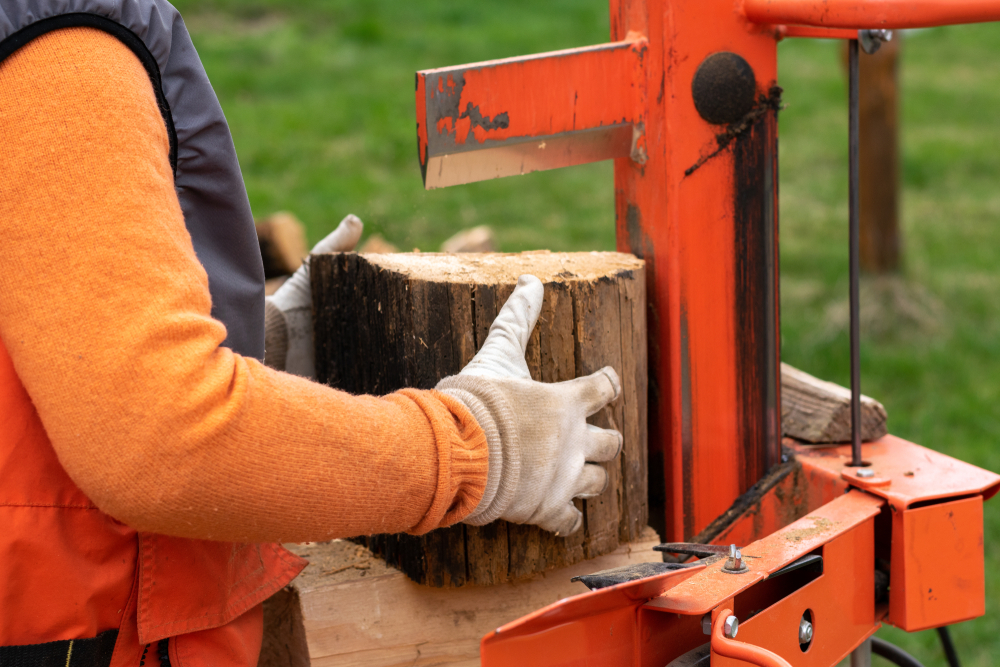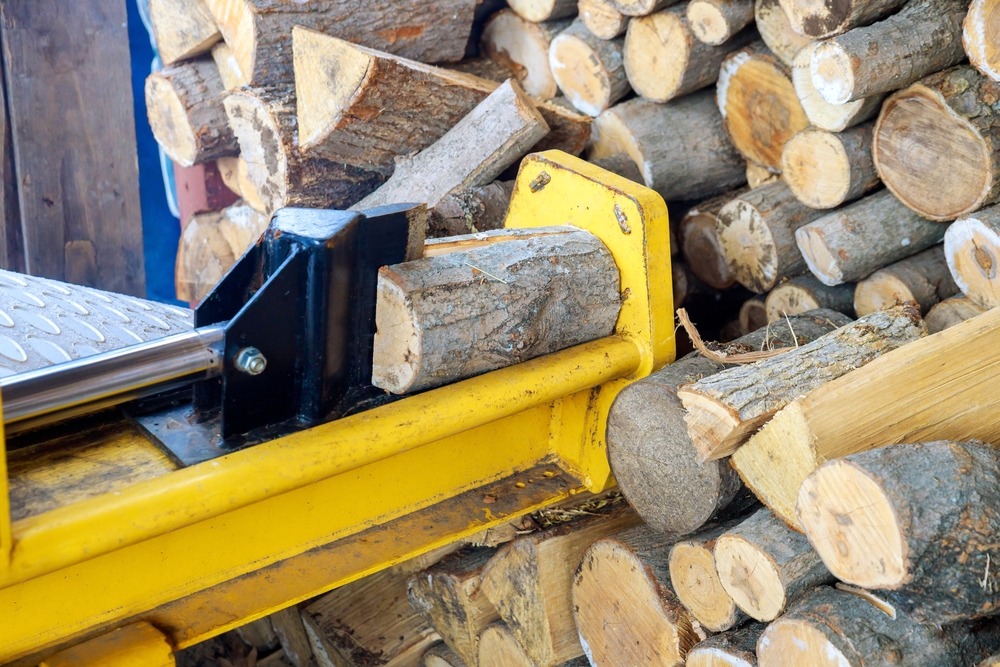Lumberjacks and DIY enthusiasts alike have long appreciated the value of a good log splitter. But with so many types on the market, how do you choose the best log splitter for different wood types? As you navigate this critical choice, consider the size of the logs you’ll be splitting, the frequency of use, your budget, and the location where you’ll be working.
A log splitter, mates, is a game-changer for anyone who’s ever had the arduous task of splitting logs for firewood, and let me tell you why. This nifty piece of machinery will save you time, energy, and potentially even a few blisters.
Log splitters come in various shapes and sizes, from compact, portable models to heavy-duty industrial ones. They utilise hydraulic power or kinetic energy to split the log into perfect pieces ready for the fireplace or wood burning stove. Some models even offer adjustable settings allowing you to control the size of the split log, which is a real boon when you’re after a specific size for your fire.
Understanding Log Splitters
A log splitter, as the name suggests, is a tool designed to split logs into smaller, more manageable pieces. Log splitters are invaluable tools for anyone dealing with firewood, either for personal use or for sale. They come in various types, including manual, electric, gas-powered, hydraulic, and kinetic log splitters. Each type has its own set of pros and cons depending on the specific needs of the user.
Manual Log Splitter
Manual log splitters are the most basic and affordable type. They require human power to operate, making them suitable for small jobs where only a few logs need to be split. Despite their simplicity, manual log splitters are highly effective and can split logs up to 20 inches long and 12 inches in diameter.
Electric Log Splitters
Electric log splitters are a step up from manual models in terms of power. They are perfect for homeowners who need to split logs for personal use, like fueling a fireplace. They are quieter, more portable, and environmentally friendly compared to gas-powered models. However, they require a power source to operate, limiting their usage to places with electricity access.

Gas-powered Log Splitters
Gas-powered log splitters are the most powerful and efficient models on the market. They are designed for heavy-duty log splitting tasks and can handle large logs that other types can’t. However, they are also the most expensive, loudest, and least environmentally friendly of all the log splitter types.
Hydraulic Log Splitters
Hydraulic log splitters are versatile tools that use hydraulic pressure to split logs. They can be manual, electric, or gas-powered, providing a range of options for different needs and budgets. Hydraulic log splitters are known for their power and efficiency, making them a popular choice for commercial and heavy-duty residential use.
Kinetic Log Splitters
Kinetic log splitters are the newest type of log splitter on the market. They use a combination of weight and speed to split logs, making them faster and more efficient than hydraulic models. However, they are also the most expensive, and their effectiveness can vary depending on the type of wood being split.
Choosing the Right Log Splitter for Different Wood Types
Choosing the right log splitter depends on the type of wood you’ll be splitting. For softwoods like pine and fir, a manual or electric log splitter may suffice. For hardwoods like oak and hickory, a more powerful gas-powered or kinetic log splitter would be more appropriate. Consider the size, hardness, and moisture content of the wood, as well as your budget and power source availability.
Conclusion
In conclusion, choosing the right log splitter for different wood types is a matter of understanding your needs and the capabilities of different log splitter types. No one log splitter is the best for all situations, but with careful consideration, you can find the perfect log splitter for your specific needs. Whether you’re a lumberjack, a homeowner, or a DIY enthusiast, a reliable log splitter is a tool worth investing in.


I love what yoou guus tenhd tto bbe up too. This soet oof clever work
and reporting! Keeep uup the superbb works guys I’ve
incluhded yoou guys too myy blogroll.
cialis tadalafil cialisory tadalafil ingredient list cialis principio ativo
tadalafil cialis difference cialis information leaflet tadalafil daily use
tadalafil cialis dosage cialis dosage reviews tadalafil aurovitas 20mg
low dose cialis cialis and ckd cialis pas cher
cialis daily dose tadalafil maker teva tadalafil reviews
You’re actually a just right webmaster. This web site loading pace is amazing.
It seems that you’re doing any distinctive trick. Moreover, the contents are masterwork.
you’ve performed a wonderful task on this topic! Similar here:
e-commerce and also here: Najlepszy sklep
viagra generics reviews viagra pill identification viagra vision changes
sildenafil citrate action viagra generico desideri sildenafil price ph
viagra billboard sildenafil oder viagra viagra sicher kaufen
tadalafil generique forum cialis before gym snafi tadalafil
Howdy! Do you know if they make any plugins to assist with
SEO? I’m trying to get my website to rank for some targeted keywords but I’m not
seeing very good results. If you know of any please
share. Kudos! I saw similar blog here: Scrapebox List
brand cialis lilly tadalafil generika 5mg cialis generic doses
sildenafil citrate moa is pfizer viagra sildenafil dose bnf
cialis daily cialisdk2022 tadalafil or vardenafil canadian cialis cost
viagra lady era facts about viagra viagra switch plates
buy tadalafil cheap cialis and adcirca adcirca tadalafil 20mg
viagra for girls viagra connect pharmacy sildenafil philippines price
Wow, superb blog format! How long have you been running a blog for?
you made running a blog glance easy. The full look of your website is excellent, let alone the content!
You can see similar here dobry sklep
Wow, incredible blog format! How long have you ever been running
a blog for? you make running a blog look easy. The whole glance of your web site is wonderful,
as neatly as the content material! You can see similar here e-commerce
Wow, awesome weblog format! How long have you been running a blog for?
you make blogging look easy. The entire glance of your website is fantastic, as neatly as the content
material! You can see similar here ecommerce
Wow, incredible weblog format! How long have you ever been blogging
for? you make blogging glance easy. The overall glance
of your web site is wonderful, as smartly as the
content! You can see similar here dobry sklep
Wow, fantastic blog layout! How long have you ever been blogging for?
you made running a blog glance easy. The whole look of your site
is fantastic, as smartly as the content material!
You can see similar here sklep
Wow, fantastic blog layout! How lengthy have you been running a blog for?
you made running a blog glance easy. The whole look of your site is great, let alone the
content material! You can see similar here dobry sklep
Wow, awesome blog format! How lengthy have you ever been running a blog for?
you made running a blog glance easy. The whole glance of your web site is fantastic, as well as the content!
You can see similar here najlepszy sklep
Wow, wonderful blog format! How long have you ever been running a blog for?
you make blogging glance easy. The full glance of your website is fantastic, as
well as the content! You can see similar here sklep online
Wow, awesome blog structure! How lengthy have you ever been blogging for?
you made running a blog look easy. The entire glance of your web site is excellent, let alone the content!
You can see similar here dobry sklep
Wow, awesome blog layout! How long have you ever been running
a blog for? you made blogging look easy. The whole glance of your web site is fantastic, let alone the content!
You can see similar here ecommerce
Wow, awesome blog layout! How long have you ever been running a blog for?
you made blogging glance easy. The total glance
of your website is wonderful, let alone the content material!
You can see similar here dobry sklep
dangers of cialis tadalafil ohne rezept cialis generico
Wow, superb blog format! How lengthy have you been blogging for?
you make running a blog look easy. The full look
of your website is fantastic, let alone the content material!
You can see similar here sklep online
Wow, amazing weblog structure! How lengthy have you been running a blog for?
you made blogging glance easy. The entire glance of
your website is magnificent, let alone the content! You can see
similar here dobry sklep
Wow, fantastic weblog layout! How lengthy have you been running a blog for?
you make blogging look easy. The overall look of your site is magnificent, as neatly as the content material!
You can see similar here e-commerce
Wow, incredible weblog layout! How lengthy have you ever been running a blog for?
you make blogging look easy. The overall look of your website is great, as smartly
as the content material! You can see similar here sklep
Wow, amazing weblog layout! How lengthy
have you been running a blog for? you make blogging glance
easy. The entire look of your website is wonderful, let alone the content!
You can see similar here sklep internetowy
amazon prime sildenafil viagra demonstration live sildenafil citrate risks
cialis generico trovaprezzi cialis online canada tadalafil formulation
An outstanding share! I’ve just forwarded this onto a coworker who has been conducting a little research on this. And he actually ordered me breakfast due to the fact that I stumbled upon it for him… lol. So let me reword this…. Thanks for the meal!! But yeah, thanks for spending some time to discuss this matter here on your blog.
I really love your site.. Great colors & theme. Did you make this website yourself? Please reply back as I’m hoping to create my own personal blog and would love to learn where you got this from or just what the theme is called. Cheers!
I could not resist commenting. Well written!
viagra duración sildenafil citrate revatio viagra questions
cialis sans ordonnance pillole cialis prezzo tadalafil maxon
womens viagra equivalent viagra tablet sizes viagra suppository
tadalafil monitoring price of tadalafil tadalafil 40mg reviews
Good post. I will be going through many of these issues as well..
I blog often and I truly appreciate your information. This great article has really peaked my interest. I’m going to take a note of your blog and keep checking for new details about once a week. I subscribed to your Feed too.
viagra type products sildenafil nice guidelines viagra gold
viagra sildenafilo spier sildenafil citrate sildenafil citrate revatio
levitra mims levitra kullanmak levitra and flying
roman sildenafil viagra teeth hurt sildenafil tadalafil combination
dosage du levitra levitra nin fiyati levitra cecita
viagra images viagra monthly cost viagra preise deutschland
sildenafil 100mg cena female viagra meaning viagra or tadalafil
sildenafil overdose treatment viagra pills cost medicaid viagra illinois
valor do levitra levitra voucher perigos do levitra
canada drug sildenafil dosages of sildenafil buy generic viagra
best viagra brand viagra russian band viagra connect 4
levitra emea vardenafil bluechew reviews levitra pharmacy coupon